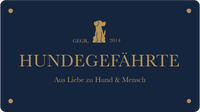Factors influencing the dog and its behavior on a leash

Why dogs pull on the leash
When it comes to problem areas with the dog, two topics come to the fore: The strong pulling on the leash and Leash aggression . These two topics are often linked. The development of a canine personality disorder usually has to do with the way the dog is managed and the challenges this poses for him.
This explains what an everyday dog (moves outside of a fixed area, meets other dogs of other breeds in and outside the territory and is, above all, on a leash and therefore limited in communication) needs to be as relaxed and socially competent as possible being able to walk on a leash.
In order to meet the demands of an everyday dog, you have to act differently than in classic dog training. There is also a new factor: there are emotional ties to the dog, owners value that their dog is healthy and lives a long time. This is not a relevant factor in livestock farming.
First phase of growth - socialization of the dog
During the first phase of socialization, the dog learns to assess itself and the environment. This mainly happens in the first 1.5 years (completion around 3 years).
If he is on a leash very often during this time and cannot interact on the leash, then this development will be made very difficult.
- Get to know the surroundings
- Getting to know others and introducing yourself to the neighborhood (wanting to take territory for yourself by urinating)
- Assess your own strengths and assess the strengths of your counterpart
- Learn to interpret body movements and facial expressions, learn to communicate via spatial distance (greeting dogs from the side, circling each other, maintaining distance if necessary)
- Learn the rules of dog language
- Develop self-esteem
Aggressive dog behavior on a leash
Things that can happen if the dog is walked on a leash a lot and/or with the wrong leash:
- Reactions due to insecurity (of the dog or the owner) in the form of flight or attack
- Automated, learned behaviors through previous experiences in the brain (dog encounter = trigger of stress)
- Complete lack of interest in the environment, fear of interaction
- Aggressive reactions TO the other dog, who appears very stressed and aggressive (spiral of violence because both dogs see each other as the trigger for the pressure on the neck)
- Behavior in order to be able to catch up on experiences. E.g. "ADHD" = The dog survives
- Behaviors reinforced by breeding (searching for prey, increased irritability in dogs from Schutzhund lines, acting out herd protection behavior)
Other factors why dogs pull hard on the leash or bark constantly
The dog is often unconsciously provoked by the owner to pull on the leash. This occurs because the dog's originally reflexive behavior is automatically triggered by certain leadership devices such as collars and chest harnesses. This means that the dog is even unconsciously asked to pull by the owner through:
- Feeling of pain and interruption of air supply during natural behavior (collar)
- Triggering the hunt (rushing) by pulling on the dog from behind (chest harness)
- Provocation through the threat of violence used in classic dog training in the event of non-obedience (kicking, choking)
- Learned experience that there is a constant threat of pain due to the infliction of pain when a stimulus (e.g. another dog) appears or due to the prohibition of being allowed to interact socially (communication = pain) -> dog reacts with aggression/escape instead of avoidance/obedience
Most problems on a leash arise from ignoring the dog's natural reactions and needs. These inherent behaviors ensure the dog's survival in nature (territory, territory, food).
In these 5 videos you can find out what the most common mistakes in dog training are and so you can also choose a dog trainer intelligently if you need support. A professional should be able to explain to you how a dog learns and what reactions are natural consequences.
5 free videos on the most common mistakes in dog training for everyday dogs:
www.hundesocialization.de

